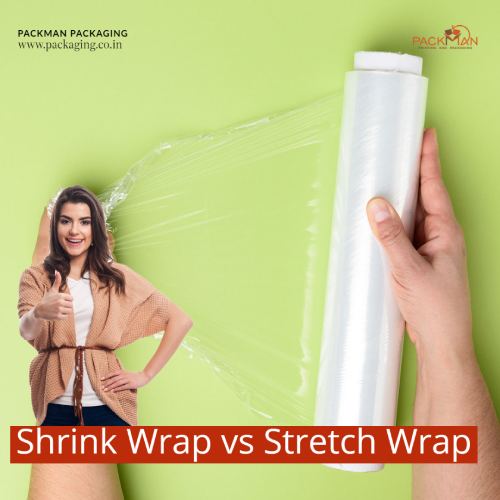The importance of wrapping products cannot be overstated in today’s packaging industry. It serves as a vital link between manufacturers, retailers, and consumers, fulfilling multiple crucial functions.
It not only acts as a sturdy shield, safeguarding the goods from external elements such as dust, moisture, and physical damage during transportation and storage but also serves as a means of identification and branding.
Shrinkwrapping and stretch wrapping are two distinct methods employed in the packaging industry, each with its own unique characteristics and applications. The differences between the two have been well explained in this article by Packman Packaging India’s top manufacturer, supplier, and wholesaler of shrink wraps and stretch wraps.
- Objective: Stretch wrapping is the stretchable plastic film that is used to secure loads of multiple products, typically on pallets. The film is stretched to about 300% of its natural size and then shrinks back when in place, creating a firm hold on the goods. In contrast, shrink wrapping is wrapped loosely around the products and heated until it reaches 100 to 150 ºC then cooled to shrink the packaging and conform to the product’s shape.
- Material: Stretch wrapping is composed of polyethylene plastics. Shrink-wrapping is composed of polyolefin plastics.
- Application: Stretch wrapping finds extensive usage in warehouses, logistics, and industrial settings, where bulk packaging and efficient distribution are paramount. From electronic goods to medical products, and canned beverages to live trees and plants, stretch wrapping is a popular choice for shipping and storing these items.
- Shrink-wrapping helps in bundling multiple items together, such as beverage cans, bottles, or boxes, providing stability and preventing them from shifting or getting separated. It is widely used for covering foods; for example, cheese, meats, and vegetables.
- Appearance: Stretch wrapping may result in a more utilitarian appearance, with the film stretched tightly around the product or pallet, focusing on stability and protection rather than aesthetics. Shrink wrapping provides a neat and visually appealing finish as the film tightly conforms to the contours of the product, enhancing its appearance and allowing for product visibility.
- Protection and Durability: Stretch wrapping offers protection against minor dust and moisture, but it may not provide the same level of security against tampering. However, the stretch film’s elasticity and tensile strength contribute to load stability and resilience during transportation. UVI stretch films can protect products stored outdoors from UV rays. Shrink wrapping provides excellent protection against dust, moisture, and tampering, creating a barrier around the product. It also resists punctures and tears.
- Cost implications: Stretch wrapping is a cost-effective packaging solution as it usually requires a stretch wrap dispenser or machine, which is generally more affordable. It also requires less material and labor thus reducing packaging costs. Shrink wrapping in contrast requires special equipment, such as a heat tunnel or a heat gun, to apply heat and shrink the film around the load which is quite expensive.
- Sustainability: Stretch wrapping is generally considered more sustainable than shrink wrapping due to its lower material usage and energy consumption, as well as its higher recyclability.
- Visibility: Stretch wrapping offers better visibility of the packaged goods due to its transparent or semi-transparent film, while shrink wrapping can reduce visibility as the film tightly conforms to the load. While both techniques safeguard products, they differ in several aspects. It is always better to consult a packaging expert to determine which method is better suited for your needs.





